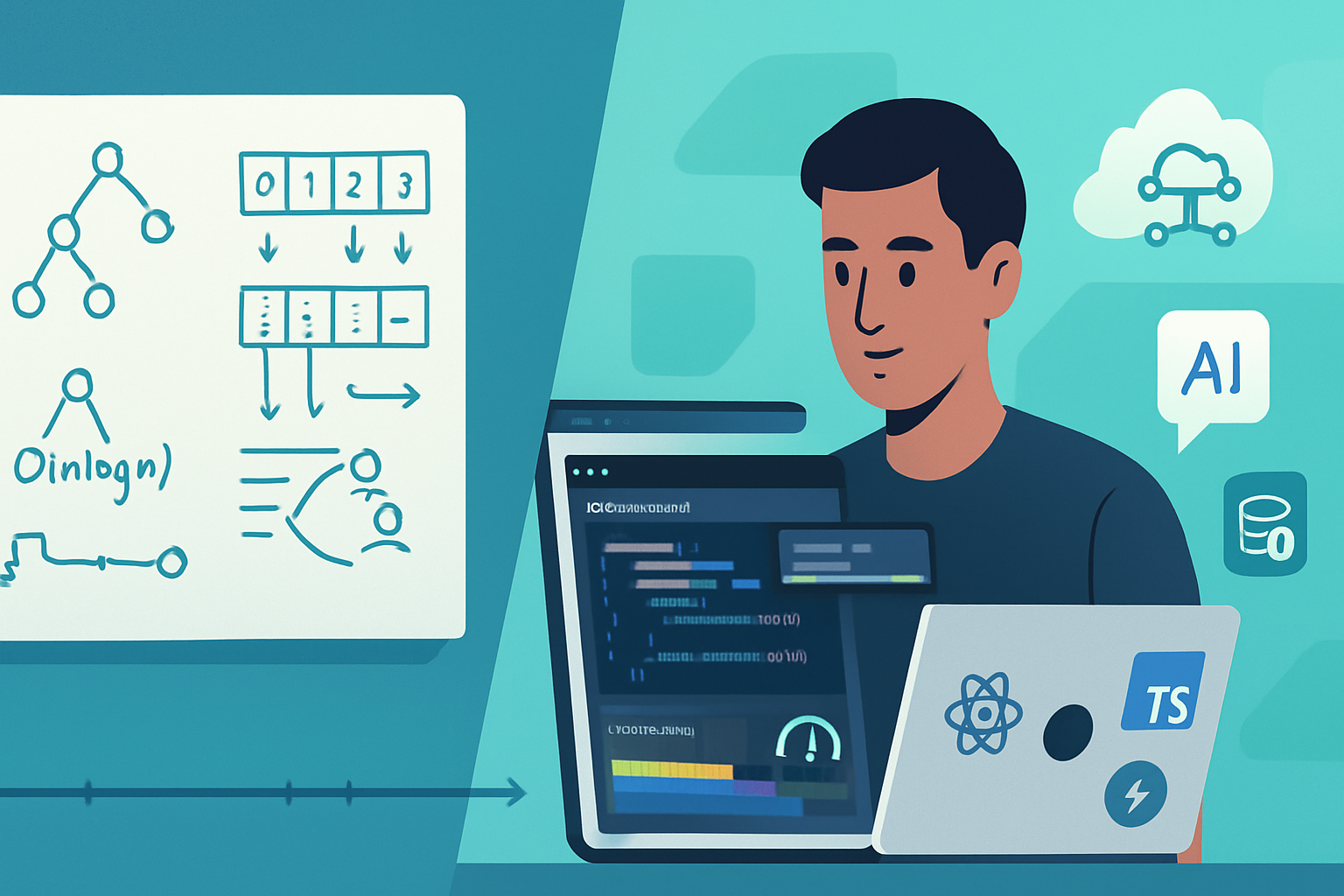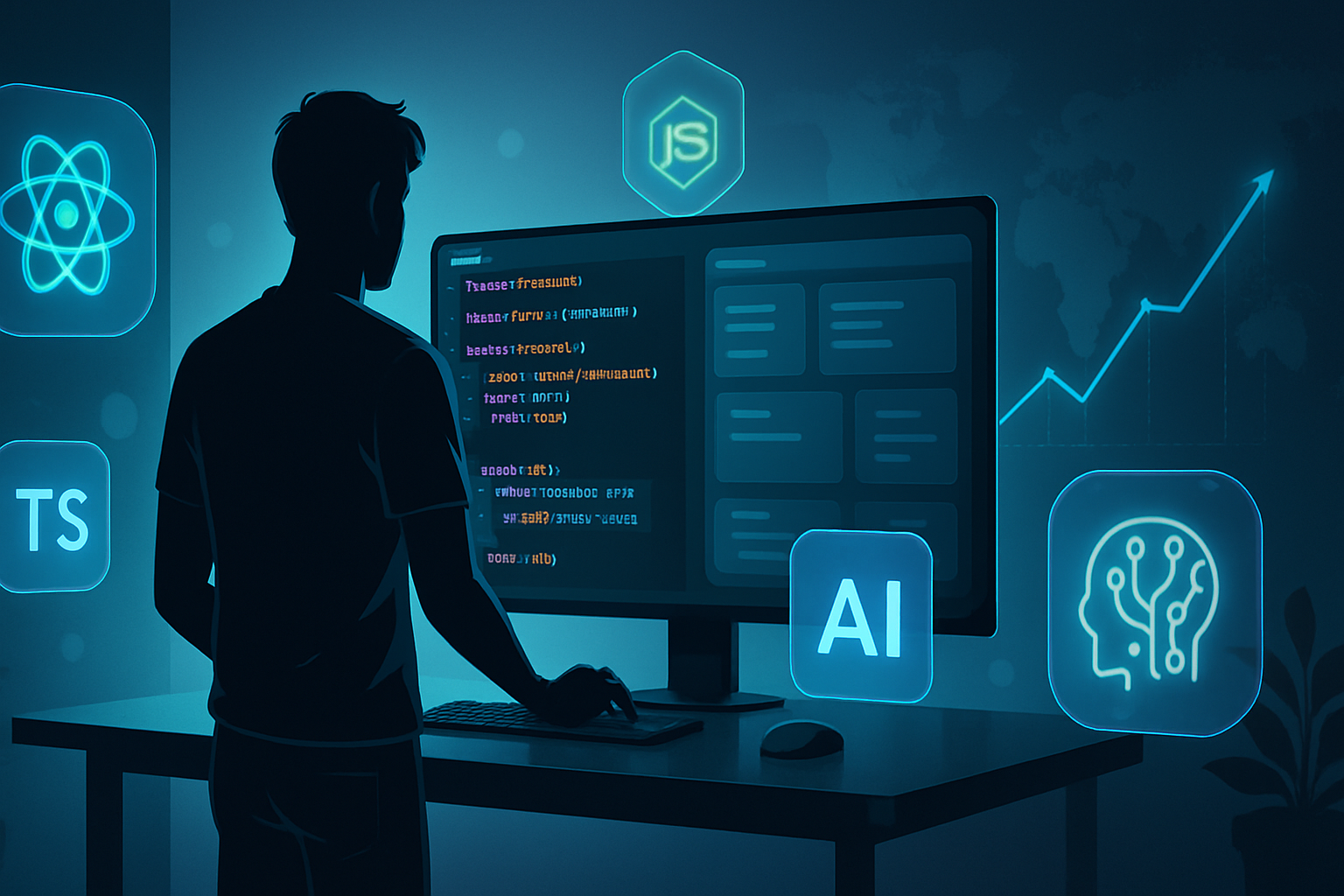· career · 6 min read
From Beginner to Rockstar: A 5-Year JavaScript Engineer Career Roadmap
A practical, year-by-year career roadmap that takes you from novice JavaScript enthusiast to a confident, hireable (and promotable) engineer in five years-complete with milestones, project ideas, learning resources, and measurable goals.

Outcome first: in five years you can move from reading your first JS tutorial to shipping production code, leading projects, mentoring others, and being seen as a reliable, high-impact JavaScript engineer. You will have a portfolio of meaningful projects, the ability to architect and troubleshoot real systems, and the communication skills to get promoted or land senior roles.
Why this roadmap works: it balances deliberate skill-building, practical projects, and career craft-so you’re not just learning concepts but shipping value.
How to use this roadmap
- Treat each year as a stage with focused outcomes and measurable checkpoints.
- Combine deliberate learning (courses/docs) with real projects.
- Revisit and adapt annually-tech evolves; fundamentals compound.
Year 0 → Year 1: Foundations - From zero to building real apps
Goal: Ship your first interactive web app and get comfortable with the JavaScript ecosystem.
Key skills
- Core JavaScript: variables, functions, scope, closures, async/await, promises.
- DOM manipulation and browser APIs.
- HTML & CSS fundamentals (responsive design).
- Git, command line basics, npm/yarn.
- One modern framework (React is recommended as a first pick).
Project ideas (resume-ready)
- Personal portfolio: responsive site with a blog or project gallery.
- To-do app with CRUD + localStorage and simple state management.
- A small clone (e.g., simplified Twitter feed) fetching a public API.
Learning resources
- MDN Web Docs for JavaScript and web fundamentals: https://developer.mozilla.org/
- Eloquent JavaScript (book): https://eloquentjavascript.net/
- Free interactive practice: https://www.freecodecamp.org/
- React docs: https://react.dev/
Milestones to hit
- Push 3–5 projects to GitHub with clear READMEs.
- Deploy at least one app (GitHub Pages, Vercel, Netlify).
- Be comfortable with debugging in the browser devtools.
Year 1 → Year 2: Solidifying - From hobby projects to production basics
Goal: Build larger apps, learn backend basics, and understand how production code is maintained.
Key skills
- Advanced JS patterns, module systems, bundlers (Vite/Webpack).
- TypeScript basics.
- Node.js and Express (or Fastify) for simple APIs.
- RESTful API design, HTTP fundamentals.
- Automated testing: unit tests with Jest; integration tests.
Project ideas (resume boosters)
- Full-stack note-taking app: React + Node + PostgreSQL (or SQLite), user auth.
- E-commerce mock: product list, cart, order flow, protected routes.
- CI/CD pipeline: connect GitHub to automated tests and deployments.
Learning resources
- Node.js docs: https://nodejs.org/
- TypeScript handbook: https://www.typescriptlang.org/docs/
- Testing with Jest: https://jestjs.io/
- Tutorials and structured paths: https://frontendmasters.com/ and courses on React+Node
Milestones to hit
- Ship 1–2 end-to-end apps with a backend and database.
- Add unit and integration tests; keep test coverage at a healthy level for critical modules.
- Understand and use Git branching (feature branches, pull requests).
Year 2 → Year 3: Growth - From implementer to dependable engineer
Goal: Work on codebases that matter, learn maintainability, and contribute to team processes.
Key skills
- TypeScript fluency and stricter typing patterns.
- Component architecture and state management (React + hooks, context, or state libs).
- API design best practices and error handling.
- Testing strategy: E2E with Cypress, integration tests, contract testing basics.
- Performance basics (bundle splitting, lazy loading, web vitals).
Project ideas (real-world grade)
- Real-time app: chat or collaborative editor using WebSockets or WebRTC.
- SaaS-style app with billing flow (Stripe sandbox) and role-based access control.
- Contribute to an open-source library or a popular repo-fix bugs and write docs.
Learning resources
- Cypress docs: https://www.cypress.io/
- Web performance basics: https://web.dev/
- Open source contribution guides: https://docs.github.com/en/get-started/quickstart/contributing-to-projects
Milestones to hit
- Merge regular PRs to non-trivial repos (yours or others).
- Lead at least one small feature from design to deployment.
- Be comfortable diagnosing and fixing production bugs.
Year 3 → Year 4: Specialization - From generalist to trusted specialist
Goal: Own critical parts of a product, mentor juniors, and specialize (frontend, backend, full-stack, infra).
Specialization paths (pick one primary, keep secondary skills)
- Frontend specialist: accessibility, advanced performance, animation, micro-frontends.
- Backend/Platform specialist: Node performance, stream processing, databases, caching, queues.
- Full-stack engineer: system design across client and server, infra-as-code, deployment automation.
Key skills
- System design fundamentals for mid-scale systems.
- Observability: logging, metrics, tracing (Prometheus, Sentry, OpenTelemetry).
- Scaling databases and caching strategies (Redis, Postgres tuning).
- Security basics: auth flows, OWASP top 10.
Project ideas (impact-focused)
- Build and document an internal micro-service or reusable component library.
- Implement observability on an app-add monitoring dashboards and alerting.
- Architect a multi-service demo app with CI/CD, infra as code (Terraform), and automated deploys.
Learning resources
- System Design Primer (GitHub): https://github.com/donnemartin/system-design-primer
- Observability resources: OpenTelemetry docs: https://opentelemetry.io/
- Security basics: OWASP Top 10: https://owasp.org/www-project-top-ten/
Milestones to hit
- Be the go-to person for a subsystem.
- Mentor 1–2 junior engineers and perform code reviews regularly.
- Deliver measurable product improvements (faster load times, fewer incidents).
Year 4 → Year 5: Leadership & Influence - From specialist to rockstar engineer
Goal: Lead technical decisions, influence product direction, and grow others; prepare for senior/lead roles.
Key skills
- Architecture and tradeoff analysis.
- Cross-team leadership and asynchronous communication.
- Hiring and interviewing skills.
- Business literacy: how engineering choices affect metrics like MAU, retention, unit economics.
Project ideas (high impact)
- Lead a cross-functional initiative-migrate a legacy module, design a new platform feature, or build a company-wide library.
- Create or manage developer workflows: standardize testing, release, or CI pipelines.
- Publish technical content: blog posts, conference talks, or open-source tools.
Learning resources
- Interview prep (algorithms & DS): https://leetcode.com/
- Leadership and communication: books, internal mentorship programs, public speaking meetups.
- Advanced JavaScript: in-depth blog series and community discussions (JSConf, company engineering blogs).
Milestones to hit
- Lead projects that moved business metrics.
- Hire, onboard, or mentor multiple engineers.
- Be comfortable owning architecture reviews and tradeoff discussions.
Ongoing: Skills and habits that compound every year
- Code reading: read real codebases weekly.
- Deliberate practice on algorithms and system design (weekly/biweekly).
- Write: document learnings in a blog or notes.
- Networking: maintain a GitHub, LinkedIn, and attend local meetups or conferences.
- Time for reflection: revise your roadmap annually and seek feedback from peers or mentors.
Useful tools and services
- Version control: Git + GitHub/GitLab.
- Deployments: Vercel, Netlify, Heroku, or cloud providers (AWS/GCP/Azure).
- CI/CD: GitHub Actions, CircleCI.
- Testing: Jest, React Testing Library, Cypress.
Links and references
- MDN Web Docs: https://developer.mozilla.org/
- Eloquent JavaScript: https://eloquentjavascript.net/
- FreeCodeCamp: https://www.freecodecamp.org/
- React: https://react.dev/
- Node.js: https://nodejs.org/
- TypeScript: https://www.typescriptlang.org/
- Cypress: https://www.cypress.io/
- System Design Primer: https://github.com/donnemartin/system-design-primer
- LeetCode: https://leetcode.com/
- OpenTelemetry: https://opentelemetry.io/
- OWASP Top 10: https://owasp.org/www-project-top-ten/
Interview readiness checkpoints by level
- Junior (0–2 years): can explain JavaScript fundamentals, build and deploy apps, answer basic algorithm questions, and demonstrate at least 2 projects.
- Mid (2–4 years): solid TypeScript, testing, architecture basics, ownership of features, and can handle frontend/backend interview rounds.
- Senior (4+ years): system design, scaling, leadership, mentoring, and measurable product impact.
Checklist before applying for next-level roles
- 3+ substantial, deployed projects with source and clear README.
- Examples of production impact (PRs that improved performance, uptime, or developer productivity).
- Consistent contribution history (GitHub) and at least one open-source PR or internal ownership.
- A set of STAR stories for behavioral interviews.
6 practical 90-day sprints you can run in year 1–2
- Month 1–3: JavaScript & Portfolio - Learn JS basics and publish a portfolio.
- Month 4–6: React App - Build a full-featured SPA and deploy it.
- Month 7–9: API & Auth - Add a backend with auth and persist data.
- Month 10–12: Tests & CI - Add tests, automate runs, and set up CI pipelines.
- Month 13–15: Performance & Monitoring - Optimize bundle size and add basic observability.
- Month 16–18: Open Source & Networking - Contribute to 1–2 repos and write about your work.
Final note
This roadmap is not a rigid prescription-it’s a guide to help you prioritize and build momentum. Learn deliberately. Ship often. Seek feedback. Mentor others when you can. Keep a track of small wins and let them compound. In five years, with focused work and thoughtful projects, you won’t just be a JavaScript developer-you’ll be the engineer people rely on.



